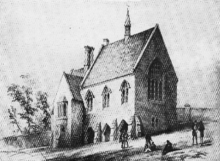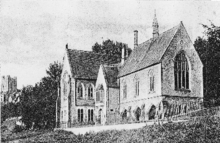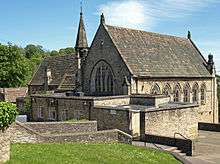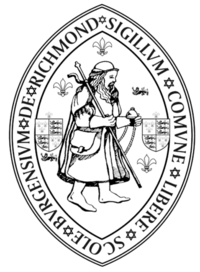Richmond School
|
School Seal | ||||||||||||||||||||||||||||||
| Established | Unknown, records exist since 1361. Current establishment founded 1971. (precursors 1566, 1940, 1950)[1] | |||||||||||||||||||||||||||||
|---|---|---|---|---|---|---|---|---|---|---|---|---|---|---|---|---|---|---|---|---|---|---|---|---|---|---|---|---|---|---|
| Type | Community school | |||||||||||||||||||||||||||||
| Head Master | Ian Robertson | |||||||||||||||||||||||||||||
| Founder | Elizabeth I[1][2] | |||||||||||||||||||||||||||||
| Location |
Darlington Road Richmond North Yorkshire DL10 7BQ England 54°24′24″N 1°43′29″W / 54.406710°N 1.724630°WCoordinates: 54°24′24″N 1°43′29″W / 54.406710°N 1.724630°W | |||||||||||||||||||||||||||||
| Local authority | North Yorkshire | |||||||||||||||||||||||||||||
| DfE number | 815/4076 | |||||||||||||||||||||||||||||
| DfE URN | 121680 Tables | |||||||||||||||||||||||||||||
| Ofsted | Reports | |||||||||||||||||||||||||||||
| Staff | >150 | |||||||||||||||||||||||||||||
| Students | c. 1,457[3] | |||||||||||||||||||||||||||||
| Gender | Mixed | |||||||||||||||||||||||||||||
| Ages | 11–18 | |||||||||||||||||||||||||||||
| Colours |
| |||||||||||||||||||||||||||||
| Website |
www | |||||||||||||||||||||||||||||
Richmond School and Sixth Form College, often referred to simply as Richmond School, is a comprehensive school in North Yorkshire, England. It was created by the merger of three schools, the oldest of which, Richmond Grammar School, is of such antiquity that its exact founding date is unknown. The first mentions of it in writings, however, is estimated, to be between 1361 and 1474. It was officially ratified as an educational establishment in 1568 by Elizabeth I.[1][2]
The school is situated on the outskirts of Richmond, near the Yorkshire Dales. It accepts both boys and girls and serves a wide catchment area across most of the north-west corner of North Yorkshire, including Swaledale.
In mid 2017 it was announced that Ian Robertson would be stepping down as Head Master at Christmas 2017 and the position of Head Teacher would be filled by current Deputy Head Teacher Jenna Potter[4].
History
Richmond Grammar School
Richmond School was the first school in Richmondshire. It accepted only boys and its only entry requirements were that pupils could read and write. Its original founding date is not known, however it first appears in a registry estimated to have been written in 1361–1474. It was awarded a charter ratifying its status on 14 March 1568 by Queen Elizabeth I and was one of the first free grammar schools in England.[2] The school was built on what is now the churchyard of St Mary's Church,[1][5] which stands opposite to and further up the hill to the former Richmond Lower School Building. In 1677 a new building replaced the Elizabethan one and this was used until 1850 when the school moved into a smaller building which still stands and until 2011 was used for teaching year 7 pupils.
The name of the school from its foundation was Richmond School as it was the only school in the town for a long period of time. In later years it was referred to locally as "The Grammar School" although this was not its official name. Following the merger of the school with the Secondary Modern and the Girls' High School into a single comprehensive school the decision was made to retain the name 'Richmond School' for the new establishment.
Notable heads
- Rev. Anthony Temple (1724–1795). Temple succeeded in getting 29 of his pupils sent to Oxford and Cambridge.[1]
- James Tate (1771–1843), Headmaster 1796–1833. Tate was even more successful; Richmond School become a nationally known school for classical learning. Tate sent up many scholars to Cambridge (they were known as "Tate’s Invincibles"). 21 became fellows, 13 of them at Trinity College.
- Thomas Henry Stokoe (1833–1903), Headmaster 1863–1871. Stokoe was a renowned clergyman and author.
 The Original 1850 School Building |
 The 1850 building with later extension. |
 An alternative view of the 1850 building and extension taken in 2009. This was part of Richmond Lower School, until its closure in 2012. |
Richmond Girls’ High School
In 1940 a Girls’ High school was built, designed by Modernist architect Denis Clarke Hall.[5] The school was built approximately 1 mile (1.6 km) from the Boys Grammar School near Darlington Road, having its main entrance in The Avenue.
Richmond Secondary Modern School
In 1950 Richmond Secondary Modern School was built[5] to accommodate those who had not passed their 11-plus exam and so did not qualify for admission to either Richmond School or the Girls' High School. Large buildings were constructed about 200 yards from the Girls’ High School.
Establishment of Richmond School (Comprehensive)
In 1971 all three schools merged to create a comprehensive school named Richmond School.[5] The then-headmaster of the Grammar School, J.D. Dutton, became the headmaster of the new combined school. All three original sites were still used but for different purposes. The school was split into three sections: Lower School for Year 7, Middle School for Years 8–10 and Upper School for Years 11–13. These were situated in the former Richmond (Grammar) School, the former Secondary Modern School and the Girls’ High School respectively, although significant extensions were added to all sites until the school’s investment as part of a DfES 'Building Schools for the Future' programme.
Recent developments
In January 2006 the school was successful in bidding for a DfES grant of £30m to be spent redeveloping the school.[6] A large factor that played a part in the grant was that Richmond is the only school in North Yorkshire to have sites which are 1 mile apart. In addition to the £30m a successful bid was made to make the school sustainable. This brought the total investment to over £32m. In 2009 it was announced that those entering the school in the academic year 2010–11 would be the last to use the original 1850 site (now called Lower School) in their first year in the school; all years would be taught at the same Darlington Road site and Lower would be sold off.
Governors resignation
In February 2014, the Governing body of the school resigned en masse in response to North Yorkshire Education Authority issuing the school with a Warning Notice under the Education and Inspections Act 2006.[7] In their resignation statement, the Chair of the Governing Body rejected the assertions in the Warning Notice as unevidenced and contrary to the opinions expressed in Ofsted's recent inspection report.[7] The Local Authority confirmed that measures were underway to appoint an Interim Executive Board.
School seal
In the Elizabethan Charter it was stated that Richmond Grammar School had the right to a "common seal for their businesses," and in 1566-67 a new seal for the school was introduced. The seal was still in existence in 1958.
In the centre of the seal was the figure of Saint James of Compostela. For several years Richmond Grammar School published an annual collection of poetry and prose writing by pupils in a small publication called "The Compostelian".
A description of the seal is found in L.P. Wenham's Book (page 27): "The Central figure is that of St. James the Greater in pilgrim's garb. His feet are bare, he has a bushy beard, wears a long, loose dress, has an escallop shell on his broad-brimmed hat, a strip or wallet hangs at his side from his girdle, his left hand holds a rosary and a small barrel or gourd, while in his right hand he carries a palmer's staff. At each side of him, upon Gothic shaped shields are the arms of France (new) and England quarterly; in the field are three lilies of France and two leopards of England."[8]
The legend around the edge of the seal reads in Renaissance capitals:
SIGILLVM COMVNE translates as "the common seal", DE RICHMOND means "of Richmond", while LIBRE SCOLE BVRGENSIVM means "of the independent [free] school of the town".
The whole legend, in Elizabethan Latin, means in English "The common seal of the independent school of the town of Richmond".
Uniform

School uniform consists of black trousers or a skirt, a white shirt a school tie and a navy blue school jumper or black blazer with the school seal embroidered in colour. The legend on the uniform's seal is not the original Latin, but instead is simply 'Richmond School Yorkshire'.[9] The previous school tie was of navy blue, gold and burgundy School colours. From 2010 ties became of block colour dependent on the academic year of pupils.
Performing Arts

Richmond School has a tradition of drama, dance and music. The school has links with Richmond's Georgian Theatre Royal where it regularly performs plays. Once a year the school produces a show, performed within the school and usually with a live orchestra, a set constructed by the Art Department, and professional lighting and sound (assisted by a team of students). Local primary school children are invited to a matinée.
| Date | Show | Director | Main Cast |
|---|---|---|---|
| July 2017 | Joseph and the Amazing Technicolour Dreamcoat | ||
| July 2016 | Freya | Mrs A Southworth-Gedeye | |
| December 2012 | The Wizard of Oz | Miss A Southworth | Dorothy: Sophie Overin |
| December 2011 | The Sound of Music | Mrs L Moss | Maria:Rebecca Blenkiron and Frances Allison, Captain von Trapp: Daniel Overin |
| February 2011 (postponed due to extreme weather) | Cider with Rosie | Mr I Henderson | |
| December 2009 | Oliver! | Miss A Southworth | Oliver: Sophie Overin, Fagin and Mr Brownlow: Ben Bason, Dodger: Dan Overin and Sam Calvert, Nancy: Sophie Holden and Sarah Boddy, Noah:Ben Cain, Sykes: Joe Tankard |
| December 2008 | Little Shop of Horrors | Miss A Southworth | Seymour Krelborn: Chris Morris, Audrey: Ashleigh Fayers, Audrey II: Michael Ash, Mr Mushnik: Matthew Clark |
| December 2007 | A Funny Thing Happened on the Way to the Forum | Miss A Southworth | Psedolus: Robert Knibbs, Hero: Joe Tankard, Philia Rosey Purkiss-McEndoo, Hysterium: Ben Bason, Senex: Joe Gray, Domina: Ashleigh Fayers[10] |
| December 2006 | Joseph and the Amazing Technicolor Dreamcoat | Mr M Kirkham | Joseph: Joe Gray and Ben Lacey, Pharaoh: Stephen Marsh, Narrator: Sarah Harrison, Jacob: Chris Masterman |
| December 2005 | Animal Farm | Mrs J Demkiw and Mr M Kirkham | Boy: Ben Bason, Mr Jones, Matthew Thompson, Old Major: Aled Buttrey, Snowball: Emma Kemp, Napoleon: Sam Watkinson, Boxer: Stephen Marsh[11] |
| December 2004 | Bugsy Malone | Mrs J Demkiw | Bugsy: Sam Watkinson, Blousey: Natasha Wood, Fat Sam: Aled Buttery, Dandy Dan: Matt Houghton[12] |
| December 2003 | Les Misérables | Ms B Cunningham | |
| December 2002 | A Midsummer Night's Dream | Ms B Cunningham |
Sport
The school has a strong tradition of sport. Until 2003 male students at the Lower School had to perform a 1-mile run to and from playing fields at Easby. Nowadays, the school has several playing fields and pitches at its Darlington Road site. These include cricket pitches, several full-size football and rugby pitches, an all-weather AstroTurf pitch and a large grass athletics track which is locally known as "Wembley" as its dimensions are so close to those of the famous stadium. As part of the redevelopment of the school a large sports hall and gym were also constructed.[13] The school allows the local community sports programmes to use its facilities out of term time and multiple training sessions take place at the site.
The school offers primarily a choice of rugby or football to boys and hockey and netball to girls as part of their compulsory education. However, the school offers multiple extra-curricular clubs and teams including athletics, golf, trampolining and cheerleading among others.[14]
Sporting teams are popular including a mixed hockey team which won the national title in 2008.[15] Rugby and football are also popular with various wins.
Headmasters
Richmond Grammar School
- 1392–1393 Stephen Moys
- 1397–? Richard Forister
- 1436/7–? John Gardiner
- 1545-1548 John More
- 1577–? John Clarkson (Trinity College, Cambridge)
- 1608–1612 Richard Bland
- 1612–1613 Thomas Thompson
- 1613–1617 William Lambert (St John's College, Cambridge)
- 1617–1618 Sander (or Alexander) Hutton
- 1618–1620 John Jackson (Christ's College, Cambridge)
- 1620–1629 John Bathurst
- 1629–1630/1 Samuel Picarde (St John's College, Cambridge)
- 1630/1–1639 John Beckwith
- 1639–1648 John Bathurst
- 1648–1696 John Parvinge (Sidney Sussex College, Cambridge)
- 1696–1722 William Thompson
- 1722–1750 Robert Close (St John's College, Cambridge)
- 1750–1795 Anthony Temple (Sidney Sussex College, Cambridge)
- 1796–1833 James Tate I (Sidney Sussex College, Cambridge)
- 1833–1863 James Tate II (Trinity College, Cambridge)
- 1863–1871 Thomas Henry Stokoe (Lincoln College, Oxford)
- 1871–1884 James Snowden (St John's College, Cambridge)
- 1884–1890 Jean Rougier Cobu (Jesus College, Oxford)
- 1890–1895 Alfred Edward Rubie (Brasenose College, Oxford)
- 1895–1903 Douglas Rucker Smith (Queen's College, Oxford)
- 1903–1906 John Monteith Furness (King's College, Cambridge)
- 1906–1913 Algernon Richard Prestwich (Selwyn College, Cambridge)
- 1913–1919 Hago Sharpley (Corpus Christi College, Oxford)
- 1919–-1928 Thomas Charles Martin (Birkbeck, London)
- 1928–1950 Frank Charles Thackeray Woodhead (Hertford College, Oxford)
- 1950–1953 Thomas Gordon Charles Woodford (St Edmund Hall, Oxford)
- 1954–1959 Donald Alfred Frith (Christ's College, Cambridge)
- 1959–1962 Robert Dacres Baynes (Trinity College, Cambridge)
Richmond School
- 2018– Jenna Potter[18]
Notable former pupils
Richmond Grammar School
- Thomas Chapman, Master of Magdalen College, Oxford
- Charles Grey, 2nd Earl Grey, British Prime Minister[19]
- Marcus Gervais Beresford (1801–1885), Archbishop of Armagh
- Lewis Carroll (Charles Lutwidge Dodgson) (1844–46), writer[2]
- Dr Gordon Johnson (1954–1961), President, Wolfson College, Cambridge
Richmond Girls’ High School
- Brenda Hale, Baroness Hale of Richmond, DBE, QC, PC, FBA (Hon) (Born 1945), Justice of the Supreme Court of the United Kingdom.
Richmond School
- Theo Hutchcraft (1997–2002), half of the synthpop duo Hurts
- Joanne Jackson (1997–2002), British Olympic swimmer
- Nicola Jackson, British Olympic swimmer
- Calum Clark (2000–2005), England U-20 international rugby player[20]
References
- 1 2 3 4 5 6 Wenham 1958
- 1 2 3 4 "A Brief History of Richmond". Richmond Grammar School. Retrieved 28 December 2010.
- ↑ "Richmond School Ofsted 2017" (PDF). Retrieved 17 February 2017.
- ↑ http://www.richmondshiretoday.co.uk/richmond-school-deputy-appointed-new-headteacher/
- 1 2 3 4 The History of Richmond School – A Summary, Richmondschool.net. Retrieved 28 December 2010.
- ↑ "New School Update, Background". Richmondschool.net. Archived from the original on 10 February 2010. Retrieved 28 December 2010.
- 1 2 "Richmond School governors step down en masse". Darlington and Stockton Times. 21 February 2014. Retrieved 28 February 2014.
- ↑ Wenham 1958, p.27
- ↑ "Uniform Policy". Richmond School. Retrieved 28 December 2010.
- ↑ A Funny Thing Happened On The Way To The Forum Programme: 3
- ↑ Animal Farm Programme: 4
- ↑ Bugsy Malone Programme: 6
- ↑ "Students flock to new community sports facilities" (PDF). Richmond School. Retrieved 29 December 2010.
- ↑ "School Departments | Physical Education". Richmond School. Retrieved 29 December 2010.
- ↑ "First national title for Richmond". The Northern Echo. Retrieved 29 December 2010.
- 1 2 "Proud headteacher bows out with top-class results". The Northern Echo. Retrieved 29 December 2010.
- ↑ "Richmond School's head pledges: "We want to be the best."". The Northern Echo. Retrieved 29 December 2010.
- ↑ http://www.richmondshiretoday.co.uk/richmond-school-deputy-appointed-new-headteacher/
- ↑ http://fretwell.kangaweb.com.au/pdfs/Edward%20Kay.pdf
- ↑ Welcome to the Official Website of Leeds Carnegie | We're Back!
Literature
- Wenham, Leslie P. (1958). The History of Richmond School, Yorkshire. The Herald Press. ASIN B0018H5RA2.
- Animal Farm Programme. Richmond School. 2005.
- Bugsy Malone Programme. Richmond School. 2004.
- A Funny Thing Happened On The Way To The Forum Programme. Richmond School. 2007.
